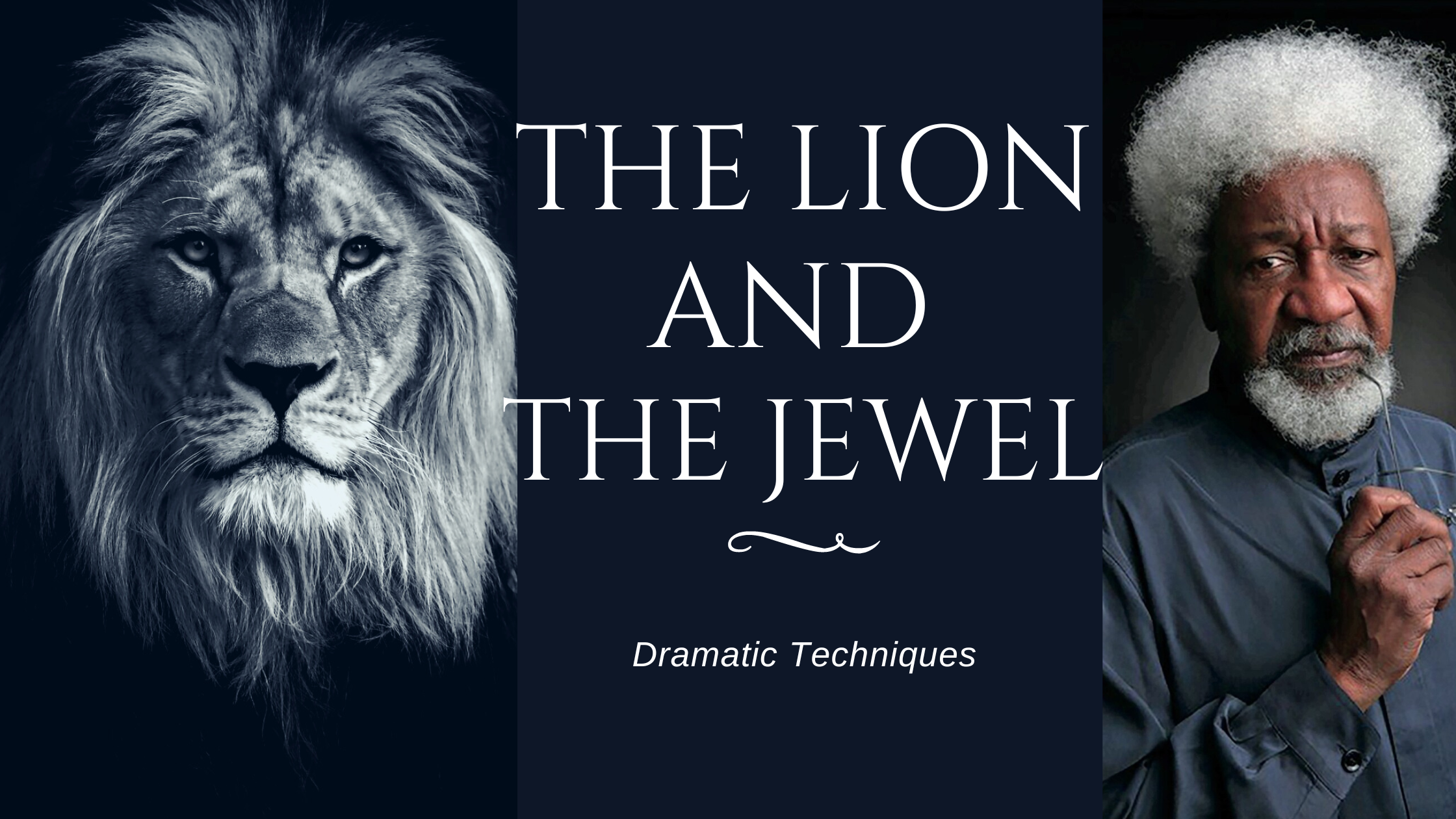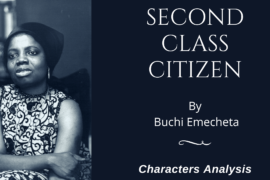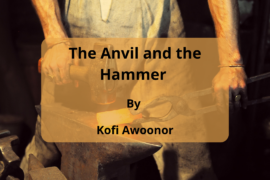In this article, I’ll look at the various Dramatic Techniques in The Lion and The Jewel by Wole Soyinka
Wole Soyinka’s The Lion and the Jewel is a comic play which explores the struggle between Western “civilization” and “medieval” African culture as well as a battle between wit and beauty, and so on.
In my previous posts, I’ve discussed the Plot summary, the themes, character analysis, and the figures of speech in the play The Lion and The Jewel by Wole Soyinka.
The most evident and, perhaps the most recurring dramatic techniques employed in the play are flashback, mime, play within a play, and plot twists.
Dramatic Techniques in The Lion and The Jewel by Wole Soyinka
Flashback
Flashback is a change (in the form of plays, literary films, or works) in a previous time or scene that disrupts the normal progression of the plot.
It is the recollection of events within a work of literature. The same can be seen inside The Lion and the Jewel.
The first flashback takes place shortly after Sidi was informed that her images were featured in the magazine. Along with her female informants, as well as the coerced Lakunle she recounts the events leading up to her fame-making moment, most likely the arrival of an unknown into Ilujinle Village.
The flashback is accomplished with the help of drums, improvisations, imitation, and mime. With this, the audience is on the same level as the characters.
The Flashback device also appears in Lakunle’s recounting of the incident in which Baroka used bribery to get his white Surveyor to divert a railroad track that was supposed to run through his village.
Mime
Mime is the use of motions and gestures without words during a play. The Lion and the Jewel have plenty of mimes. The first time mime is used occurs in the recollection of the entrance of the stranger into Ilujinle. A large portion of the story is told by bodily movement. Starting with the awkward (technically Lakunle’s) handling of the devil’s horse (automobile) as well as his amazement at the enchanting beauty of Sidi and his running after by villagers and shutters on the periphrastic “one-eyed box” (a camera) and on and on.
While this mime gets interrupted by Baroka, it is short. He gets absorbed into the mimetic practice quickly to take on his role as Village Head.
Another clear example is mime occurs when Lakunle told the pair that is Sidi as well as Sadiku of the way in which Baroka blocked the plans for railway tracks to go throughout Ilujinle Village. This decision, he explains to Baroka’s fear of the railway track could bring in “civilization,” which could undermine his authority within the village.
The mime, although punctuated by Lakunle’s commentary on Baroka his wrestler, and the white Surveyor, two warders, and prisoners; shows their movements and gestures, and obviously, the way Baroka got the Surveyor to agree to gifts to ensure that the railway track could be constructed elsewhere than his village.
Mime is also put into play following Sidi’s conversation with Baroka. The mummers later came to Lakunle and Sadiku as they waited for Sidi. The mummers mimic Baroka’s fall from manhood, a testimony of how Sadiku has informed them of Baroka’s secret and his apparent inability to do anything.
Frame Story
Also known in other ways as a play within a play is emphasized through the recollection of the Stranger’s journey into Ilujinle. The characters of The Lion and the Jewel (notably the Girls, Lakunle, Sidi as well as the later Baroka) perform a scene within the play, deciding to assign them roles.
The girls, for their own, play a shifty They first act as the vehicle for the Stranger, and later as the villager. Lakunle is forced to play his role as the Stranger since he seems like the wandering Stranger in his mannerisms. Sidi is simply Sidi and Baroka is Baroka.
This improvisation is an obvious example of an impromptu story within the narrative or, more specifically, a play within the context of a drama. This means that there is one brief scene within The Lion and the Jewel.
Plot Twist
The term “plot twist” refers to a story twist as a literary device that causes a dramatic alteration in the plot or the expected result of the plot of the fiction work.
Based on the chronological arrangement of the events of The Lion and the Jewel, no one would have believed that Sidi would marry Baroka. We can infer this from the way she reveled in the humiliation of Baroka and his posh office when his photo was positioned side-by-side in the magazine alongside the latrine of the village. She even has a feeling of pride when she is given more acceptance and gains more attention by virtue of her appearance.
However, when Sadiku offered her Baroka’s offer Sidi is adamantly against the idea, insisting on her newly-discovered significance and recognition of her beauty during the process. Sidi claims that she is “young and brimming” while Baroka is “spent”; she is “the twinkle of a jewel” and Baroka has “the hind-quarters of a lion”. Imagine!
It is not imagined that she’ll be caught in a trap created and controlled by the wily-goateed Baroka.
Baroka deceives everyone and everyone, including Sadiku (his spokesperson) and the public regarding his lack of power, by stating Baroka’s “my manhood ended near a week ago” assertion. He deceives the crowd.
When his plot was revealed, the viewers were not expecting the details. The false information leads to an unanticipated plot twist: the destruction of the diamond by the Lion. If the audience was aware of Baroka’s real intentions the method would be seen as an act of dramatized comical.
There is however an obvious hint, though not sufficiently explicit to clearly define Baroka’s strategy. In the opening scene in the drama (Morning), Baroka, admiring the attractive image that is Sidi, soliloquizes (an example that is a soliloquy) “Yes Yes,” yes . . . It’s been five months since I last took a wife . . . Five months of full time . . .”
This is a clear indication of his intention to take Sidi at any cost even if it was a matter of scheming to spread false information.
Foreshadowing
– When Baroka contemplates to himself at the conclusion of the first scene that it’s been 5 months since he got an elopement, it hints at the plot for him to take Sidi as his wife.
When Sadiku notices that the wrestler has left the Bale’s house, “some signs of this break on Sadiku and she begins to look a little puzzled” (55). This is a sign of Bale’s strength.
Narrator and Point of View
Third-person (Play)
Tone and Mood
The words are playful, sarcastic, jovial humorous
Protagonist and Antagonist
Protagonist: Sidi. Antagonists: Baroka and Lakunle.
Major Conflict
Will Sidi be in a position to execute her plan to tease Bale and also get married to the school teacher Lakunle?
Climax
When Sidi starts crying and tells Lakunle along with Sadiku that Baroka had fooled them all and she’s no anymore a maid.
Use of Dramatic Devices
There are some phrases: Lakunle talking about progress as well as Baroka is also discussing his thoughts regarding progress.
The denouement can be seen in Sidi’s choice to marry Baroka and Lakunle’s decision to shift his focus to a different girl.
Soyinka employs a flashback to show the white surveyor accepting Baroka’s offer to deter from putting the railway through Ilujinle.
Soyinka is satirical of self-interested, pompous, and self-confident people.
Playwright’s Style
The playwright employs a variety of stylistic techniques to embellish his work to make it more artistic and memorable
1. The script’s language is written in poetic and prosaic structures. Sadiku mostly speaks in Baroka Lakunle, Baroka and Sidi are able to speak in what seems to be poetry in simple, short lines high-pitched, and musical language. In the event that Baroka talks, his aristocratic status is undeniable. He commands respect, and everyone is able to call him ‘Kabiyesi’ or ‘Baba’, etc.
In full splendor, he says to Lakunle “Akowe. Teacher wa. Misita Lakunle” and starts to talk to him with authority. Lakunle makes use of images to woo Sidi who isn’t as well-educated as him particularly when he requests her to forget about the bride cost.
Check out his Jove manifesto on pages 36 and 38 however, while this doesn’t make logic in the eyes of Sidi, Sidi in reality appears to have written her responses to Lakunle as well as Baroka in Yoruba because she hadn’t attended the school “Out of my way, book-nourished shrimp./Do you see what strength he has given me?/That was not bad. For a man sixty/lt was the secret of God’s own draught/A deed for drums and ballads” (pp. 63-64).
Flashbacks as memories using mimes
A mime is a kind of performing without words. In the play, mimes function as flashbacks of past events as well as events from the past that are connected to the contemporary. Mimes are used to describe the photographer as well as the motorbike, car, as well as the surveyor, the dance of virility, the way civilization was delayed in Ilujinle, through the exchange of bribes, etc.
The “Stranger,” a photographer, played by Lakunle upon receiving a sudden call by the Bale is thrown on the ground in slumber by the villager. Even though he attempted to provoke the villager’s”bluff,” when he was torn, the Chief starts to show his support. Baroka asks for dry, clean clothes from the photographer and then sits him to his right, and then orders an honorary meal for him. “The photographer starts to take from’ the celebration attendees.
At a point, he pleads with the Chief to arrange for Sidi. We’re told that the photographer “arranges, Sidi in all different poses for magazines and snaps numerous photos of her. This has been done in the past, but the mime is used to remind. The devil-horse (motor car) was driven by four girls marking the guest’s (Iakunle’s) entrance into Ilujinle. The girls imitate the Lakunle clowns who perform the driving motions.
With the raucous beating of the drums, the car is supposed to move more and more quickly. There’s a crash of drums “the girls quiver and dance the stall” and the “stalling wheels” give an equivalent shudder the car has difficulties getting started. It is the driver Lakunle who climbs from the car and then “looks underneath it” All of these are fabricated in the mime to be a reflection of the past. The main “character” recalling these incidents is Lakunle performs the roles of Photographer and Stranger, and the driver keeps the same number of characters and avoids expansion of the actors.
Surprise and suspense
There is significant suspense in the play, and it is the one that controls the play’s flow, as the audience wants to be aware of what will happen later. The suspense is connected with Baroka’s sudden admission of insanity to his former spouse, Sadiku, Immediately he discovers that he is in fact pregnant, she is unable to make sense of it, but immediately joins in dancing with the ladies to exhaust the Lion.
The Bale is using Sadiku without knowing about it. his goal is to allow Sidi to lay down her guard. While she previously refused Baroka’s invitation to dinner, the revelation about the ruler’s sexual infidelity will make her reconsider the old man’s suggestion. Sidi just wants to make fun of the Bale and prove that she is not intended to be “the hindquarters of a lion” who she claims she “spent.” We’d like to know who between Baroka as well as Sidi will take home the “contest’.
We want to know how Lakunle will react to the defilement of Sidi. A second surprise comes from Sidi who, rather than be upset and likely be angry with Sadiku over her rumor-mongering, prefers to be apathetic and not have anything to have to do with Lakunle the younger man: “Mamy who -..? You thought…Did you really think that you, and I …/Why, did you think that after him/l could endure the touch of another man?” Everyone is unaware of the fact that she (Sidi) won’t “choose a watered-down,/A beardless version of unripened man” (p. 64).
Time -Set of noon, morning, and night
While the events of the play were a long time coming to pass In the play, the writer wishes for all actions to happen within a single day — morning, noon, and evening (‘unity .of timing’). The play could be completed in three hours, yet it’s presented as if it took place on a specific day. The different parts of the day appear like they are symbolic. Morning is a time of innocence and youthfulness.
It’s the time of Lakunle’s romantic love for Sidi Their love appears to be pure and a savory representation of a perfect love, where sex is not an issue the way it should be. The play’s morning scene reminds us of a story of discovery, adventure, and drinking. Noon acts as the cushion or protection between the night and morning. It signifies danger and is a sign of the clouds to come. For example, the love message from Baroka to Sidi is a sign of doom, as there is a clear distinction between the two.
Sidi then declines Baroka’s proposal, and then shortly thereafter, she chooses to accept the invitation of the old man. It’s at noon that Baroka’s offer to take advantage of the civilization by the white surveyor gets masked in the hopes of revealing the past, as well as to show how the lion would like only to take advantage of any things he can find in his home village.
The night is also a symbol of intrigue. The morning air has gone. Light has gone, and the lights are now fake and misleading. There is a rumor about Baroka’s concocted incompetence. He is the only one who knows that it’s not real. Sadiku is a fool and the fake battle of Baroka with his wrestler where Bale is victorious suggests that in the battle of the wills between Sidi and Baroka Sidi will prevail. So the grand plan to capture Sidi is realized and the bride’s price loses out.
Songs and dances
Yoruba songs and dances abound in the play. It’s an indication that the setting has been one that is culturally reflective. To draw at the eye of Lakunle on his way to school, two students are heard make a buzzing sound at Sidi, “repeatedly clapping their hands across the mouth.” The pupils were already singing the multiplication table “Three times two equals six Three times three is nine, etc. Chants by Sidi from Page 14 is taken up by all, and “they begin to dance around Lakunle, speaking the words in a fast rhythm.”
There is a clap of drums as well as soft throbbing drums “gradually swelling in volume.” It is said that the drums increase in tempo until there is an explosion of drums. The drums are used in full the ‘iya ilu’ and ‘gangan kinds of the mime, which involves Lakunle who has a drink of the local beer “two drummers.- Insist on dancing around him.” The mimes of felled trees and swung matches log-dragging. All of these are performed to the beat of the work group’s metal drums (rod on gong, etc.).
The song leaders will raise choruses of songs such as “N’ijo itoro,” “Amuda and the Ebe, Gbeje on’ipa etc. The most mimed tune is ‘N’ijo Itoro’, which is a tune from 1940, which was popularized by prisoners working manual work like cutting grass. The mime that is the 3rd one actually is the dance of Virility. It’s a performance of Baroka’s sexuality until he declares his inevitability. The youthfulness of Baroka’s sexuality is highlighted by the energetic dance moves that are accompanied by the intense beat that bala drums make.
The virility dance will not last very long since it drains energy. The dancing of virility is performed by the singer Sadiku, who is in her 70s. In between, there’s the sound of drums or fluting, box guitars the ‘sekere’ guitar, etc. On page 62, there’s a group of singers.
In Page 64, the musicians continue their music as Sidi dances and sing. Sidi sings “Mo mo te’ ni te”ni” while the crowd chants Tolani Tolani’ after Sidi. In the beginning, when Baroka throws his wrestler in a sparring match, Sidi exclaims “You won. You won!” and then breaks into a shoulder dance, and sings “Yokolu Yokolu” (Page 44). The whole show is full of dancing and songs that represent the Yoruba tradition and way of living.



